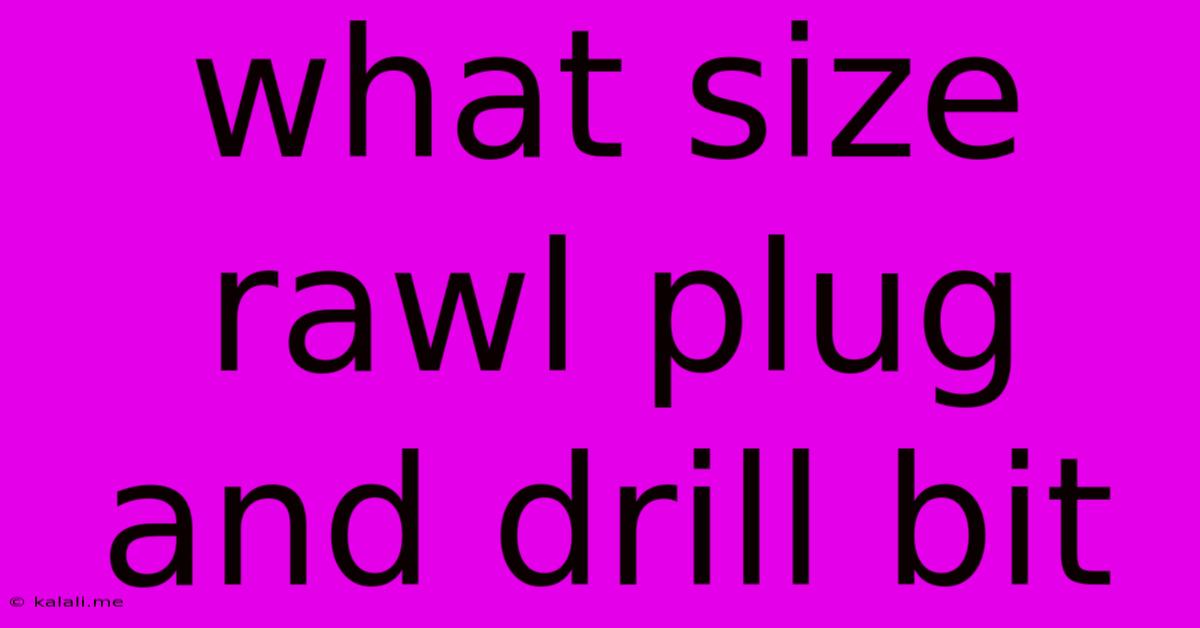What Size Rawl Plug And Drill Bit
Kalali
May 20, 2025 · 3 min read

Table of Contents
What Size Rawl Plug and Drill Bit Do I Need? A Comprehensive Guide
Choosing the right rawl plug and drill bit size is crucial for a secure and stable fixing. Getting it wrong can lead to wobbly shelves, loose picture frames, or even worse – structural damage. This comprehensive guide will help you understand the relationship between rawl plug size, drill bit size, and the weight you're supporting, ensuring your DIY projects are successful. This guide covers metric and imperial sizes, providing a clear and concise explanation for both.
Understanding the Relationship
The key is understanding that the drill bit needs to be slightly smaller than the rawl plug itself. This allows the plug to expand and grip the wall securely once the screw is inserted. The size of the drill bit and rawl plug directly correlates to the weight they can support – bigger is better for heavier items.
Metric Sizes: A Common Standard
The most common system used is metric. Here's a breakdown of common sizes and their applications:
- 6mm Rawl Plug: Requires a 5mm drill bit. Suitable for light-duty applications like small picture frames, lightweight shelves, or hooks.
- 8mm Rawl Plug: Requires a 6mm drill bit. Ideal for slightly heavier items such as medium-sized shelves or mirrors.
- 10mm Rawl Plug: Requires an 8mm drill bit. Suitable for heavier objects like large shelves, wall units, or heavier fixtures.
- 12mm Rawl Plug: Requires a 10mm drill bit. For very heavy items, requiring significant support.
Imperial Sizes: Still in Use
While less common, imperial sizes are still encountered. Remember to always double-check your rawl plug packaging for precise measurements:
- 1/4" Rawl Plug: Requires a 7/32" drill bit (approximately 5.5mm). Similar in strength to a 6mm metric plug.
- 3/8" Rawl Plug: Requires a 1/4" drill bit (approximately 6.35mm). Comparable to an 8mm metric plug.
- 1/2" Rawl Plug: Requires a 3/8" drill bit (approximately 9.5mm). Similar in strength to a 10mm metric plug.
Material Matters
The material of the wall also influences the size of rawl plug you'll need. For example:
- Plasterboard: Needs a longer rawl plug to grip effectively, sometimes needing additional support like a butterfly plug.
- Brick: Usually holds a rawl plug more securely than plasterboard, allowing for a slightly smaller size for the same weight capacity.
- Concrete: Often requires specialized concrete rawl plugs and larger drill bits for optimum performance.
Choosing the Right Size: A Step-by-Step Guide
- Determine the weight of the item: Heavier items require larger rawl plugs and drill bits.
- Identify the wall material: This affects the type and size of rawl plug needed.
- Consult the rawl plug packaging: Always check the packaging for recommended drill bit size.
- Measure twice, drill once: Ensure accuracy to avoid damage.
- Use the correct drill bit: Using the wrong size can lead to loose fixings.
Safety First!
Always wear safety glasses when drilling to protect your eyes from debris. Use a slow, steady pace when drilling to prevent cracking the wall. If unsure, consult a professional.
By following these guidelines, you can confidently choose the correct rawl plug and drill bit size for your DIY projects, ensuring strong, secure, and long-lasting results. Remember to always prioritize safety and accuracy for a successful outcome.
Latest Posts
Latest Posts
-
When Connecting Car Battery Which Terminal First
May 20, 2025
-
What Makes The Sound Louder On The String Instruments
May 20, 2025
-
Eyes Are Bigger Than The Stomach
May 20, 2025
-
What Does Bad Mean In German
May 20, 2025
-
Parking On A Single White Line
May 20, 2025
Related Post
Thank you for visiting our website which covers about What Size Rawl Plug And Drill Bit . We hope the information provided has been useful to you. Feel free to contact us if you have any questions or need further assistance. See you next time and don't miss to bookmark.